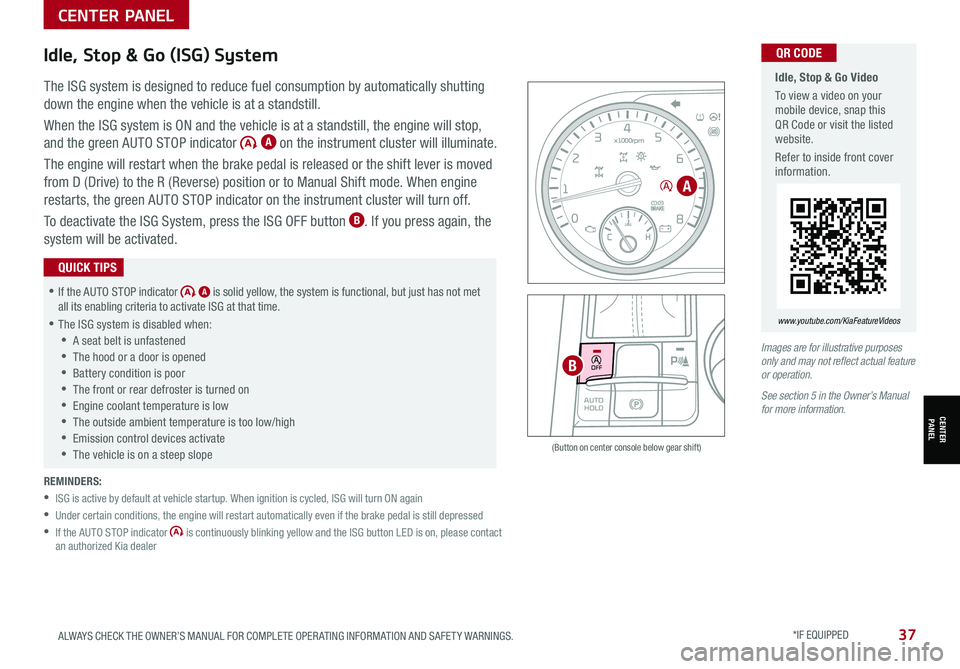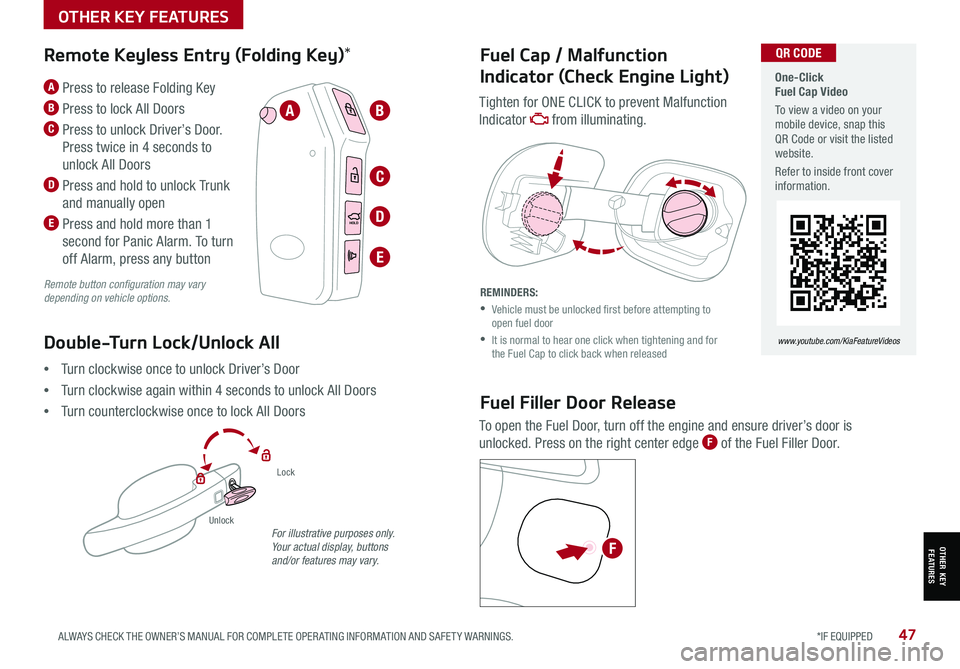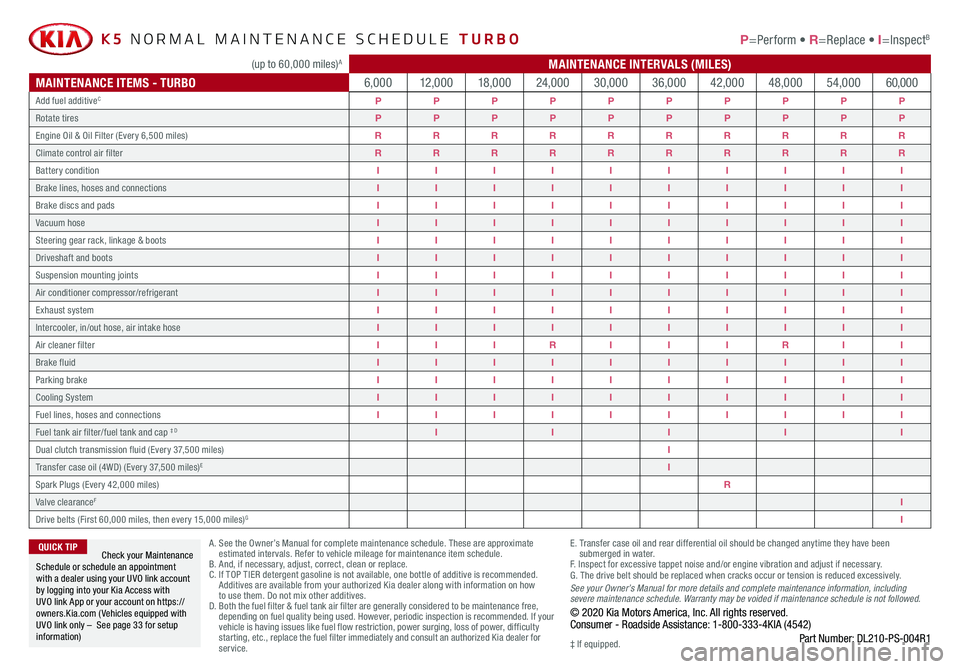fuel KIA K5 2021 Features and Functions Guide
[x] Cancel search | Manufacturer: KIA, Model Year: 2021, Model line: K5, Model: KIA K5 2021Pages: 58, PDF Size: 4.9 MB
Page 39 of 58

37ALWAYS CHECK THE OWNER’S MANUAL FOR COMPLETE OPER ATING INFORMATION AND SAFET Y WARNINGS. *IF EQUIPPED
Idle, Stop & Go Video
To view a video on your mobile device, snap this QR Code or visit the listed website.
Refer to inside front cover information.
www.youtube.com/KiaFeatureVideos
QR CODEIdle, Stop & Go (ISG) System
The ISG system is designed to reduce fuel consumption by automatically shutting
down the engine when the vehicle is at a standstill.
When the ISG system is ON and the vehicle is at a standstill, the engine will stop,
and the green AUTO STOP indicator A on the instrument cluster will illuminate.
The engine will restart when the brake pedal is released or the shift lever is moved
from D (Drive) to the R (Reverse) position or to Manual Shift mode. When engine
restarts, the green AUTO STOP indicator on the instrument cluster will turn off.
To deactivate the ISG System, press the ISG OFF button B. If you press again, the
system will be activated.
REMINDERS:
•ISG is active by default at vehicle startup. When ignition is cycled, ISG will turn ON again
•
Under certain conditions, the engine will restart automatically even if the brake pedal is still depressed
•
If the AUTO STOP indicator is continuously blinking yellow and the ISG button LED is on, please contact an authorized Kia dealer
•If the AUTO STOP indicator A is solid yellow, the system is functional, but just has not met all its enabling criteria to activate ISG at that time.
•
The ISG system is disabled when:
•A seat belt is unfastened
•The hood or a door is opened
•Battery condition is poor
•
The front or rear defroster is turned on
•
Engine coolant temperature is low
•
The outside ambient temperature is too low/high
•
Emission control devices activate
•
The vehicle is on a steep slope
QUICK TIPS
Images are for illustrative purposes only and may not reflect actual feature or operation.
See section 5 in the Owner’s Manual for more information.
0
20
40 60
80
100
120
140
160
180
200
220
240
260
0
1 2
3
4
5
6
7
8km/h
EPB
C H
x1000rpm
0
20 40
60
80
100
120
1 40
1 60
E
F
MPH
AUTO
HOLD
DRIVE
MODE
OFF
SHIFT
LOCK
RELEASE
P
R
N D
+
_
(Button on center console below gear shift)
A
B
CENTER PANEL
CENTER PANEL
Page 49 of 58

47ALWAYS CHECK THE OWNER’S MANUAL FOR COMPLETE OPER ATING INFORMATION AND SAFET Y WARNINGS. *IF EQUIPPED
One-Click Fuel Cap Video
To view a video on your mobile device, snap this QR Code or visit the listed website.
Refer to inside front cover information.
www.youtube.com/KiaFeatureVideos
QR CODE
Lock
Unlock
Remote Keyless Entry (Folding Key)*Fuel Cap / Malfunction
Indicator (Check Engine Light)
Fuel Filler Door Release
Tighten for ONE CLICK to prevent Malfunction
Indicator from illuminating.
To open the Fuel Door, turn off the engine and ensure driver’s door is
unlocked. Press on the right center edge F of the Fuel Filler Door.
REMINDERS:
•
Vehicle must be unlocked first before attempting to open fuel door
•
It is normal to hear one click when tightening and for the Fuel Cap to click back when released
A Press to release Folding Key
B Press to lock All Doors
C Press to unlock Driver’s Door.
Press twice in 4 seconds to
unlock All Doors
D Press and hold to unlock Trunk
and manually open
E Press and hold more than 1
second for Panic Alarm. To turn
off Alarm, press any button
Remote button configuration may vary depending on vehicle options.
Double-Turn Lock/Unlock All
•Turn clockwise once to unlock Driver’s Door
•Turn clockwise again within 4 seconds to unlock All Doors
•Turn counterclockwise once to lock All Doors
For illustrative purposes only. Your actual display, buttons and/or features may vary.
HOLD
HOLD
HOLDD
C
BA
E
F
OTHER KEY FEATURES
OTHER KEY FEATURES
Page 58 of 58

*IF EQUIPPED
K5 NORMAL MAINTENANCE SCHEDULE TURBO P=Perform • R=Replace • I=InspectB
A . See the Owner’s Manual for complete maintenance schedule. These are approximate estimated intervals. Refer to vehicle mileage for maintenance item schedule. B. And, if necessary, adjust, correct, clean or replace.C. If TOP TIER detergent gasoline is not available, one bottle of additive is recommended. Additives are available from your authorized Kia dealer along with information on how to use them. Do not mix other additives.D. Both the fuel filter & fuel tank air filter are generally considered to be maintenance free, depending on fuel quality being used. However, periodic inspection is recommended. If your vehicle is having issues like fuel flow restriction, power surging, loss of power, difficulty starting, etc., replace the fuel filter immediately and consult an authorized Kia dealer for service.
E. Transfer case oil and rear differential oil should be changed anytime they have been submerged in water.F. Inspect for excessive tappet noise and/or engine vibration and adjust if necessary.G. The drive belt should be replaced when cracks occur or tension is reduced excessively.See your Owner’s Manual for more details and complete maintenance information, including severe maintenance schedule. Warranty may be voided if maintenance schedule is not followed.© 2020 Kia Motors America, Inc. All rights reserved.Consumer - Roadside Assistance: 1-800-333-4KIA (4542)Part Number: DL210-PS-004R1
Check your Maintenance Schedule or schedule an appointment with a dealer using your UVO link account by logging into your Kia Access with UVO link App or your account on https://owners.Kia.com ( Vehicles equipped with UVO link only – See page 33 for setup information)
QUICK TIP
‡ If equipped.
(up to 60,000 miles)A MAINTENANCE INTERVALS (MILES)
MAINTENANCE ITEMS - TURBO6,00012,00018,00024,00030,00036,00042,00048,00054,00060,000
Add fuel additiveCPPPPPPPPPP
Rotate tiresPPPPPPPPPP
Engine Oil & Oil Filter (Every 6,500 miles)RRRRRRRRRR
Climate control air filterRRRRRRRRRR
Battery conditionIIIIIIIIII
Brake lines, hoses and connectionsIIIIIIIIII
Brake discs and padsIIIIIIIIII
Vacuum hoseIIIIIIIIII
Steering gear rack, linkage & bootsIIIIIIIIII
Driveshaft and bootsIIIIIIIIII
Suspension mounting jointsIIIIIIIIII
Air conditioner compressor/refrigerantIIIIIIIIII
Exhaust systemIIIIIIIIII
Intercooler, in/out hose, air intake hoseIIIIIIIIII
Air cleaner filterIIIRIIIRII
Brake fluidIIIIIIIIII
Parking brakeIIIIIIIIII
Cooling SystemIIIIIIIIII
Fuel lines, hoses and connectionsIIIIIIIIII
Fuel tank air filter/fuel tank and cap ‡ DIIIII
Dual clutch transmission fluid (Every 37,500 miles)I
Transfer case oil (4WD) (Every 37,500 miles)EI
Spark Plugs (Every 42,000 miles)R
Valve clearanceFI
Drive belts (First 60,000 miles, then every 15,000 miles)GI
(up to 60,000 miles)A MAINTENANCE INTERVALS (MILES)
MAINTENANCE ITEMS - TURBO6,00012,00018,00024,00030,00036,00042,00048,00054,00060,000
Add fuel additiveCPPPPPPPPPP
Rotate tiresPPPPPPPPPP
Engine Oil & Oil Filter (Every 6,500 miles)RRRRRRRRRR
Climate control air filterRRRRRRRRRR
Battery conditionIIIIIIIIII
Brake lines, hoses and connectionsIIIIIIIIII
Brake discs and padsIIIIIIIIII
Vacuum hoseIIIIIIIIII
Steering gear rack, linkage & bootsIIIIIIIIII
Driveshaft and bootsIIIIIIIIII
Suspension mounting jointsIIIIIIIIII
Air conditioner compressor/refrigerantIIIIIIIIII
Exhaust systemIIIIIIIIII
Intercooler, in/out hose, air intake hoseIIIIIIIIII
Air cleaner filterIIIRIIIRII
Brake fluidIIIIIIIIII
Parking brakeIIIIIIIIII
Cooling SystemIIIIIIIIII
Fuel lines, hoses and connectionsIIIIIIIIII
Fuel tank air filter/fuel tank and cap ‡ DIIIII
Dual clutch transmission fluid (Every 37,500 miles)I
Transfer case oil (4WD) (Every 37,500 miles)EI
Spark Plugs (Every 42,000 miles)R
Valve clearanceFI
Drive belts (First 60,000 miles, then every 15,000 miles)GI
(up to 60,000 miles)A MAINTENANCE INTERVALS (MILES)
MAINTENANCE ITEMS - TURBO6,00012,00018,00024,00030,00036,00042,00048,00054,00060,000
Add fuel additiveCPPPPPPPPPP
Rotate tiresPPPPPPPPPP
Engine Oil & Oil Filter (Every 6,500 miles)RRRRRRRRRR
Climate control air filterRRRRRRRRRR
Battery conditionIIIIIIIIII
Brake lines, hoses and connectionsIIIIIIIIII
Brake discs and padsIIIIIIIIII
Vacuum hoseIIIIIIIIII
Steering gear rack, linkage & bootsIIIIIIIIII
Driveshaft and bootsIIIIIIIIII
Suspension mounting jointsIIIIIIIIII
Air conditioner compressor/refrigerantIIIIIIIIII
Exhaust systemIIIIIIIIII
Intercooler, in/out hose, air intake hoseIIIIIIIIII
Air cleaner filterIIIRIIIRII
Brake fluidIIIIIIIIII
Parking brakeIIIIIIIIII
Cooling SystemIIIIIIIIII
Fuel lines, hoses and connectionsIIIIIIIIII
Fuel tank air filter/fuel tank and cap ‡ DIIIII
Dual clutch transmission fluid (Every 37,500 miles)I
Transfer case oil (4WD) (Every 37,500 miles)EI
Spark Plugs (Every 42,000 miles)R
Valve clearanceFI
Drive belts (First 60,000 miles, then every 15,000 miles)GI